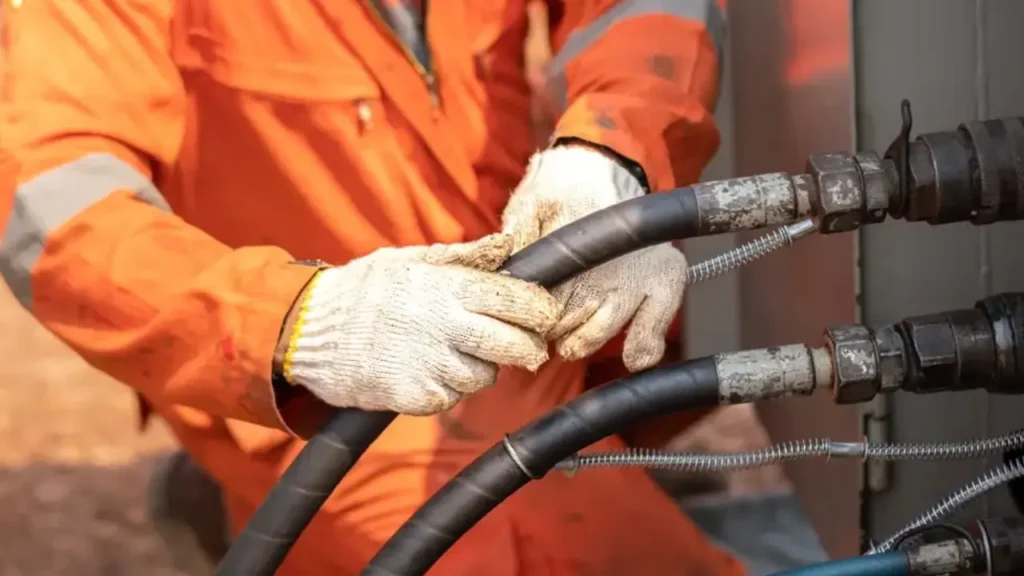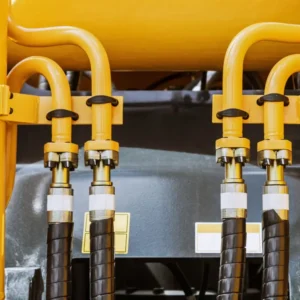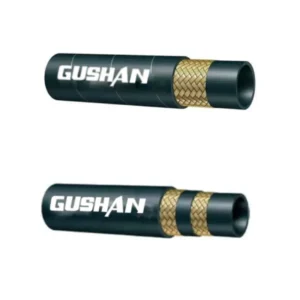Hydraulic hoses are the lifeblood of many industrial machines, powering everything from construction equipment to manufacturing processes. However, these essential components are susceptible to various forms of damage, including blistering. This seemingly minor issue can lead to significant problems, including hydraulic fluid leaks, reduced system performance, and even catastrophic failures.
In this blog, we will explore the world of hydraulic hose blistering, its causes, consequences, and prevention strategies.
What is Hydraulic Hose Blistering
Hydraulic hose blistering is a condition where small bubbles or blisters form on the outer surface of a hydraulic hose.
This often indicates internal damage or deterioration of the hose material.
Causes of Hydraulic Hose Blistering:
- Incompatible fluids: If the hydraulic fluid used is not compatible with the hose material, it can cause the fluid to permeate the hose wall and form blisters.
- High temperatures: Excessive heat can degrade the hose material, leading to blistering and potential failure.
- Chemical exposure: Exposure to certain chemicals can weaken the hose material and cause blistering.
- Internal pressure: High internal pressure can force fluid or gas through the hose wall, resulting in blisters.
Consequences of Hydraulic Hose Blistering:
- Fluid leaks: Blisters can weaken the hose wall, leading to leaks and fluid loss.
- Reduced performance: A damaged hose can restrict fluid flow, affecting the performance of hydraulic systems.
- System failure: In severe cases, blistering can lead to complete hose failure, causing equipment downtime and potential safety hazards.
Prevention and Maintenance:
- Use compatible fluids: Ensure that the hydraulic fluid used is compatible with the hose material.
- Monitor temperatures: Avoid exposing hoses to excessive heat.
- Inspect regularly: Conduct regular inspections of hoses for signs of blistering, cracking, or other damage.
- Replace damaged hoses promptly: Replace any damaged or worn hoses immediately.
- Proper storage: Store hoses in a cool, dry place, away from direct sunlight and harmful chemicals.
By taking these preventive measures, you can significantly reduce the risk of hydraulic hose blistering and ensure the reliable operation of your hydraulic systems.
Why Is the Hydraulic Hose Blistering
Hydraulic hose blistering occurs due to a variety of factors, often related to the degradation or incompatibility of the hose material with the fluid or environmental conditions. Here are the primary causes:
1. Incompatible Fluids:
- Chemical Reaction: If the hydraulic fluid is incompatible with the hose material, it can cause a chemical reaction that weakens the hose wall.
- Fluid Permeation: The fluid may penetrate the hose wall, leading to the formation of blisters on the surface.
2. Excessive Heat:
- Thermal Degradation: High temperatures can accelerate the aging process of the hose material, making it more susceptible to blistering.
- Fluid Vaporization: Heat can cause the fluid to vaporize, creating pressure within the hose and leading to blistering.
3. Chemical Exposure:
- Chemical Attack: Exposure to certain chemicals, such as solvents or acids, can weaken the hose material and cause it to blister.
4. Internal Pressure:
- Pressure Fluctuations: Sudden pressure spikes or surges can stress the hose wall, leading to the formation of blisters.
- Gas Ingestion: If gas is introduced into the hydraulic system, it can accumulate within the hose and cause blistering.
5. Improper Installation and Maintenance:
- Kinking and Bending: Excessive bending or kinking of the hose can weaken the hose wall.
- Abrasion: Abrasion from rubbing against other components can damage the hose and lead to blistering.
- Neglect: Failure to inspect and replace hoses regularly can lead to premature failure and blistering.
By understanding these causes, you can take steps to prevent hydraulic hose blistering and ensure the reliable operation of your hydraulic systems.
How to Fix Hydraulic Hose Blistering
The only solution is to replace the entire hydraulic hose. This is because blistering indicates internal damage to the hose, making it unsafe to use.
Here’s why you should replace a blistered hose:
- Fluid Leaks: Blisters can weaken the hose wall, leading to leaks and fluid loss.
- Reduced Performance: A damaged hose can restrict fluid flow, affecting the performance of hydraulic systems.
- System Failure: In severe cases, blistering can lead to complete hose failure, causing equipment downtime and potential safety hazards.
To replace a hydraulic hose, follow these steps:
- Shut Down the System: Turn off the hydraulic system and relieve any pressure in the system.
- Drain the Fluid: Drain the fluid from the hose and the connected components.
- Disconnect the Hose: Disconnect the hose from the fittings using appropriate tools.
- Measure the Hose: Measure the length, diameter, and type of fittings required for the replacement hose.
- Install the New Hose: Install the new hose, ensuring it is properly routed and secured.
- Connect the Fittings: Connect the fittings to the new hose, tightening them securely.
- Bleed the System: Bleed the system to remove any air bubbles and ensure proper fluid flow.
- Test the System: Test the system for leaks and proper operation.
Additional Tips:
- Choose the Right Hose: Select a hose that is compatible with the fluid and operating conditions.
- Proper Installation: Ensure the hose is installed correctly to avoid stress and strain.
- Regular Inspection: Conduct regular inspections of hoses for signs of wear and tear.
- Replace Worn Hoses Promptly: Replace any damaged or worn hoses immediately.
By following these guidelines, you can prevent hydraulic hose failures and ensure the safe and efficient operation of your hydraulic systems.
Guidelines For Hydraulic Hose Replacement

Replacing a hydraulic hose is a crucial task that requires careful attention to detail. Here are some essential guidelines to ensure a successful replacement:
1. Safety First:
- Shut Down the System: Always turn off the hydraulic system and relieve any pressure before starting the replacement process.
- Wear Protective Gear: Use appropriate safety gear, such as gloves and safety glasses, to protect yourself from potential hazards.
2. Assess the Damage:
- Identify the Damaged Hose: Pinpoint the exact location and extent of the damage.
- Check for Other Issues: Look for any signs of wear, kinks, or other damage in nearby hoses.
3. Select the Right Replacement Hose:
- Compatibility: Choose a hose that is compatible with the fluid, pressure, and temperature requirements of your system.
- Hose Specifications: Consider factors like hose length, diameter, and fitting type.
- Quality: Opt for high-quality hoses from reputable manufacturers to ensure durability and performance.
4. Prepare for Installation:
- Drain the Fluid: Drain the hydraulic fluid from the damaged hose and any connected components.
- Disconnect the Hose: Carefully disconnect the hose from the fittings, using appropriate tools.
5. Install the New Hose:
- Routing: Route the new hose to avoid sharp bends, kinks, or excessive stress.
- Secure the Hose: Use hose clamps or other securing methods to prevent movement and damage.
- Connect the Fittings: Connect the fittings to the new hose, ensuring a tight and secure connection.
6. Bleed the System:
- Remove Air Bubbles: Bleed the system to remove any air bubbles that may have entered during the replacement process.
- Check for Leaks: Inspect all connections for leaks.
7. Test the System:
- Functional Test: Test the hydraulic system to ensure it is functioning properly.
- Pressure Test: Conduct a pressure test to verify the integrity of the new hose and fittings.
Additional Tips:
- Regular Inspection: Regularly inspect hydraulic hoses for signs of wear, damage, or leaks.
- Proper Storage: Store spare hoses in a cool, dry place, away from direct sunlight and harmful chemicals.
- Professional Installation: If you are unsure about the replacement process, consult a qualified hydraulic technician.
By following these guidelines, you can ensure a safe and efficient hydraulic hose replacement, minimizing downtime and maximizing the performance of your hydraulic system.
Conclusion
While often overlooked, hydraulic hose blistering is a serious issue that can lead to significant problems for your machinery. By understanding the causes and consequences of this condition, you can take proactive steps to prevent it and extend the life of your hydraulic hoses.
- Regular inspections: Conduct routine inspections of your hydraulic hoses for signs of blistering and other damage.
- Proper installation: Ensure that your hoses are installed correctly to avoid stress and strain.
- High-quality hoses: Invest in high-quality hydraulic hoses from reputable manufacturers.
- Avoid excessive heat and cold: Extreme temperatures can accelerate the aging process of hoses.
- Proper storage: Store hoses in a cool, dry place, away from direct sunlight and harmful chemicals.
Ready to upgrade your hydraulic system with high-quality, blister-resistant hoses?
Contact us today to explore our extensive range of wholesale hydraulic hoses. Our expert team can help you select the right hoses for your specific application and provide valuable advice on maintenance and best practices.
Don’t let blistering compromise your machinery’s performance. Take action now and safeguard your investment.



